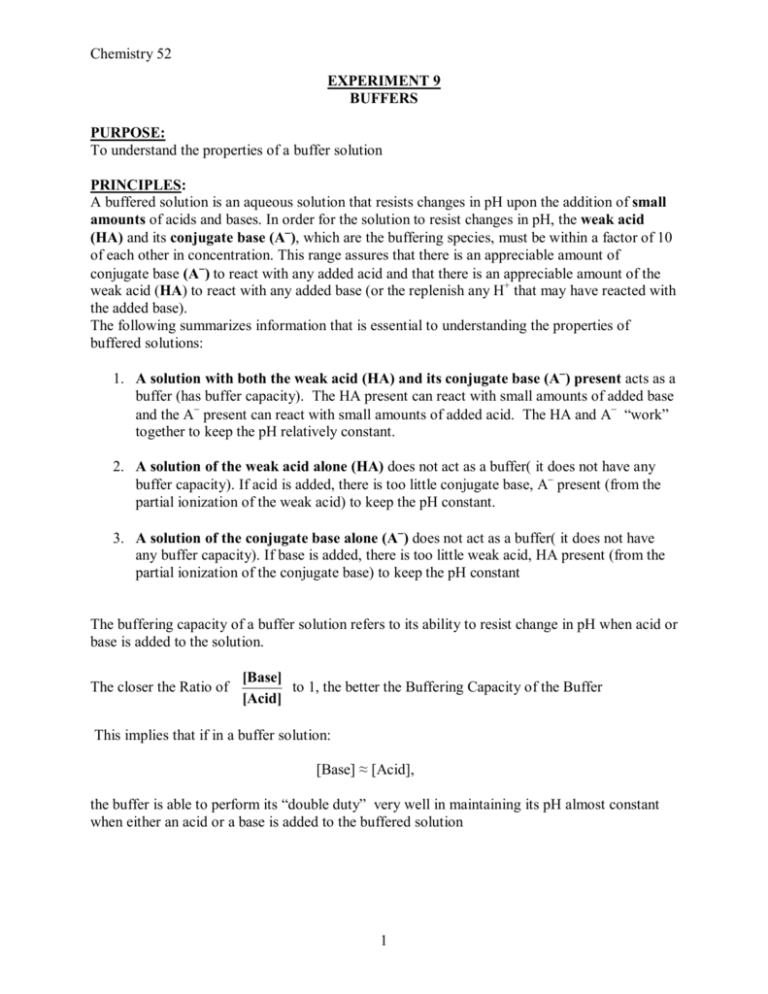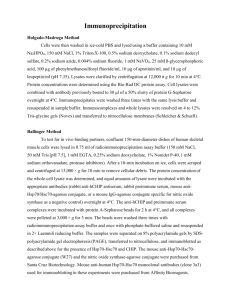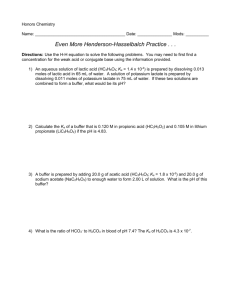Chemistry 52 1 EXPERIMENT 9 BUFFERS PURPOSE: To
advertisement

Chemistry 52 EXPERIMENT 9 BUFFERS PURPOSE: To understand the properties of a buffer solution PRINCIPLES: A buffered solution is an aqueous solution that resists changes in pH upon the addition of small amounts of acids and bases. In order for the solution to resist changes in pH, the weak acid (HA) and its conjugate base (A - ), which are the buffering species, must be within a factor of 10 of each other in concentration. This range assures that there is an appreciable amount of conjugate base (A - ) to react with any added acid and that there is an appreciable amount of the weak acid (HA) to react with any added base (or the replenish any H + that may have reacted with the added base). The following summarizes information that is essential to understanding the properties of buffered solutions: 1. A solution with both the weak acid (HA) and its conjugate base (A - ) present acts as a buffer (has buffer capacity). The HA present can react with small amounts of added base and the A- present can react with small amounts of added acid. The HA and A- “work” together to keep the pH relatively constant. 2. A solution of the weak acid alone (HA) does not act as a buffer( it does not have any buffer capacity). If acid is added, there is too little conjugate base, A- present (from the partial ionization of the weak acid) to keep the pH constant. 3. A solution of the conjugate base alone (A - ) does not act as a buffer( it does not have any buffer capacity). If base is added, there is too little weak acid, HA present (from the partial ionization of the conjugate base) to keep the pH constant The buffering capacity of a buffer solution refers to its ability to resist change in pH when acid or base is added to the solution. The closer the Ratio of [Base] to 1, the better the Buffering Capacity of the Buffer [Acid] This implies that if in a buffer solution: [Base] ≈ [Acid], the buffer is able to perform its “double duty” very well in maintaining its pH almost constant when either an acid or a base is added to the buffered solution 1 Chemistry 52 PROCEDURE Part A: Calibration and Use of pH Meters If necessary, calibrate the pH meters as directed below. Your instructor will inform you if this step can be omitted. 1. 2. 3. 4. Partly fill a 100­200 mL beaker or Erlenmeyer flask with water. Remove the protective cap from the electrode and place it a secure place. Place the pH meter electrode in the beaker of water. Rinse the electrode and wipe off the excess water with a Kimwipe. DO NOT TOUCH THE ELECTRODE WITH YOUR FINGERS 5. Place the electrode into Standard Solution at pH 7.00. Turn on the meter and wait for 1­2 minutes while swirling the electrode gently in the solution. Record pH reading. Calibrate the pH meter as closely as possible for pH = 7.00 6. Repeat Step 4 for Standard Solution at pH 4.00 7. Measure the pH of each of your six solutions (1A, 2A, 3A, 1B, 2B & 3B ) from Part I. Remember to repeat Steps 3 and 4 every time you change solutions. Record these pH measurements and calculate the average pH for each solution (1, 2 & 3) Part B: Preparation and Measurement of Solutions 1. Prepare solution 1 (Table 1) by adding the appropriate amounts of 0.1M HC2H3O2 (acetic acid), 0.1M NaOH (sodium hydroxide) and deionized water to a 150 mL beaker. (Measure your solutions with a 25 mL graduated cylinder) Solution # 1 2 3 TABLE 1 HC2H3O2 NaOH (mL) (mL) 20.00 0.00 20.00 10.00 20.00 15.00 H2O (mL) 20.00 10.00 5.00 2. Divide each solution prepared into two equal portions and place in two 50 mL beakers. Label one beaker 1A and the other 1B. 3. Measure the pH of solutions 1A and 1B, using a pH meter, and record in data table. 4. Add 2.0 mL of 0.1M HCl to solution 1A, mix and measure pH. Record in data table. 5. Add 2.0 mL of 0.1M NaOH to solution 1B, mix and measure pH. Record in data table. 6. Discard solutions in the sink, and rinse beakers with deionized water. 7. Repeat steps 1­6 with solutions 2 and 3. When you are finished with your measurements, rinse the pH meter with distilled water, wipe off the excess water with a Kimwipe and place the cap on the electrode and return the pH meter to your instructor in its original container. 2 Chemistry 52 CALCULATIONS 1. Calculate the average pH obtained from two measurements for each solution. 2. Determine the change in pH for solutions 1A, 2A, and 3A, when 2.0 mL of hydrochloric acid is added (∆pHacid) 3. Determine the change in pH for solutions 1B, 2B, and 3B, when 2.0 mL of sodium hydroxide is added (∆pHbase) 4. Average (∆pHacid) and (∆pHbase) for solutions 1A, 1B and 2A, 2B and 3A, 3B respectively. 5. Determine which solution(s) can act as a buffer. 6. If more than one solution can act as a buffer, indicate which solution has a higher buffering capacity and why. 3 Chemistry 52 NAME: _________________________ REPORT FORM Preparation of Solutions and Measurement of Solutions Solution Measured pH Average pH Average pH of solutions 1A 1B 2A 2B 3A 3B Measurement of Buffering Capacity 1. Calculate the moles of hydrochloric acid added to solution 1A, 2A and 3A: Molarity of Hydrochloric Acid: _______________ M Volume of Hydrochloric Acid added _______________ mL Number of moles of Hydrochloric Acid added: (Show calculations below) _______________ moles pH after addition of hydrochloric acid: Solution 1A: _________ Solution 2A: _________ Solution 3A: _________ 2. Calculate the moles of sodium hydroxide to added to solution 1B, 2B and 3B: Molarity of Sodium Hydroxide: _______________ M Volume of Sodium Hydroxide solution added: _______________ mL Number of moles of Sodium Hydroxide added: (Show calculations below) _______________ moles pH after addition of sodium hydroxide:: Solution 1B: _________ Solution 2B: _________ 4 Solution 3B: _________ Chemistry 52 3. Testing the buffering capacity of the three solutions TABLE IV A: Change in pH upon addition of acid (∆pHacid) Solution 1 Solution 2 Solution 3 Initial Average pH pH after the addition of ____________ moles HCl Change in pH ((∆pHacid) TABLE IV B: Change in pH upon addition of base (∆pHbase) Solution 1 Solution 2 Solution 3 Initial Average pH pH after the addition of __________ moles NaOH Change in pH ((∆pHbase) TABLE IV C: Summary of change in pH upon addition of acid or base (transfer and average your data from Table IV A and IV B above) Solution 1 Solution 2 Solution 3 Change in pH (∆pHacid) Change in pH (∆pHbase) Average change in pH: (∆pHacid + ∆pHbase) ▬▬▬▬▬▬▬▬▬▬ 2 5 Chemistry 52 Questtions: 1. Which one (or more) of the solutions meets the criteria for being a buffer solution? _____________________________________ What is the experimental evidence that supports your answer above? 2. If more than one solution meets the criteria for being a buffer solution, which solution has the highest Buffering Capacity? __________________________________ What is the experimental evidence for your answer above? [base] ) of each buffer solution identified above. [acid] NOTE: Since the concentration of acid and base are equal, you can use volumes in place of moles to determine this ratio. 3. Calculate the buffering capacity ratio ( 4. What buffering capacity ratio provides the best buffer solution? 6







